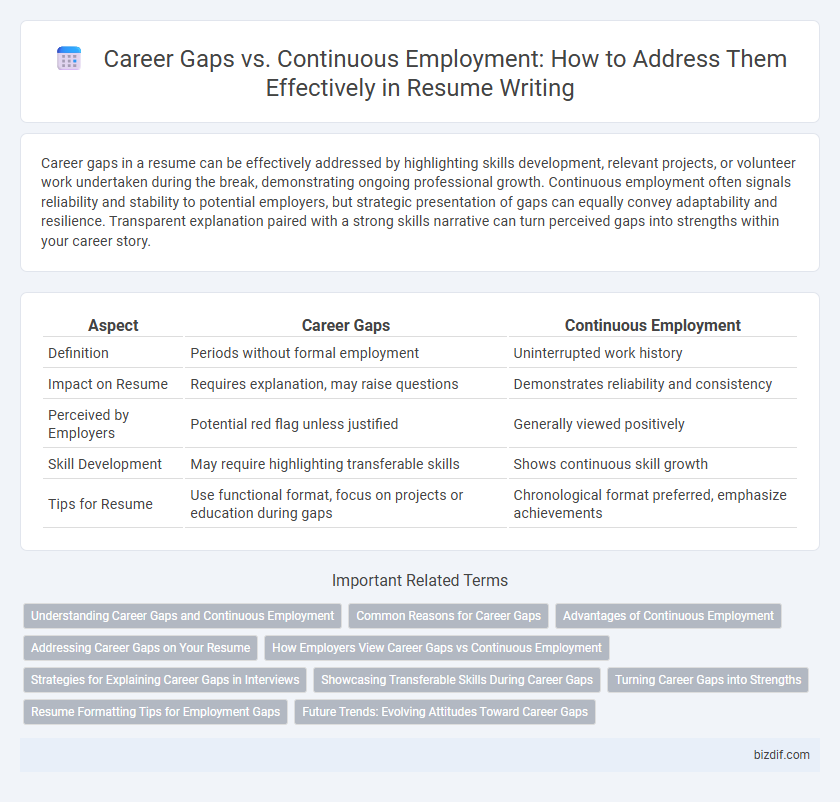Career gaps in a resume can be effectively addressed by highlighting skills development, relevant projects, or volunteer work undertaken during the break, demonstrating ongoing professional growth. Continuous employment often signals reliability and stability to potential employers, but strategic presentation of gaps can equally convey adaptability and resilience. Transparent explanation paired with a strong skills narrative can turn perceived gaps into strengths within your career story.
Table of Comparison
| Aspect | Career Gaps | Continuous Employment |
|---|---|---|
| Definition | Periods without formal employment | Uninterrupted work history |
| Impact on Resume | Requires explanation, may raise questions | Demonstrates reliability and consistency |
| Perceived by Employers | Potential red flag unless justified | Generally viewed positively |
| Skill Development | May require highlighting transferable skills | Shows continuous skill growth |
| Tips for Resume | Use functional format, focus on projects or education during gaps | Chronological format preferred, emphasize achievements |
Understanding Career Gaps and Continuous Employment
Career gaps often indicate periods of personal development, skill acquisition, or life changes, which can add value when clearly explained on a resume. Continuous employment showcases consistent work experience and reliability, appealing to employers seeking stability and sustained performance. Understanding how to present both career gaps and continuous employment effectively helps candidates align their resume with employer expectations and industry standards.
Common Reasons for Career Gaps
Career gaps often occur due to personal reasons such as pursuing further education, caregiving responsibilities, health issues, or career transitions, and acknowledging these in a resume can help maintain transparency. Employers increasingly recognize that gaps may reflect valuable life experiences or skill development outside of traditional employment. Clearly explaining career gaps with relevant achievements or learning outcomes can strengthen a resume and reduce concerns during job evaluations.
Advantages of Continuous Employment
Continuous employment enhances a resume by demonstrating consistent work experience, reliability, and dedication to potential employers. It signals professional stability and growth, often leading to higher chances of securing interviews and job offers. Employers prefer candidates with uninterrupted career histories as it suggests up-to-date skills and a strong work ethic.
Addressing Career Gaps on Your Resume
Addressing career gaps on your resume with honesty and strategic framing turns potential concerns into opportunities, emphasizing skills gained through volunteering, freelancing, or education during breaks. Highlighting relevant achievements and focusing on transferable skills demonstrates continuous professional development despite employment gaps. Tailoring your resume to reflect how these experiences align with the job role increases employer confidence in your candidacy.
How Employers View Career Gaps vs Continuous Employment
Employers often perceive continuous employment as a sign of stability, reliability, and consistent skill development, which can enhance a candidate's credibility. Career gaps may raise concerns about an applicant's commitment or recent industry experience, but transparent explanations and evidence of skill maintenance can mitigate these doubts. Hiring managers increasingly recognize diverse career paths and value candidates who demonstrate adaptability and lifelong learning regardless of employment history gaps.
Strategies for Explaining Career Gaps in Interviews
Address career gaps in interviews by framing them as periods of skill development, education, or personal growth relevant to the desired role. Highlight specific activities such as freelancing, volunteering, or certifications obtained during gaps to demonstrate ongoing professional engagement. Emphasize readiness and enthusiasm for returning to the workforce, aligning explanations with the company's values and job requirements.
Showcasing Transferable Skills During Career Gaps
Highlighting transferable skills during career gaps enhances a resume by demonstrating adaptability, problem-solving, and time management capabilities that remain relevant to future roles. Emphasizing projects, volunteer work, or education pursued during employment breaks reinforces continuous professional development and commitment to growth. Recruiters value candidates who convert career gaps into opportunities for skill accumulation, making resumes stand out in competitive job markets.
Turning Career Gaps into Strengths
Career gaps can be reframed as periods of valuable personal growth, skill development, or strategic realignment, highlighting resilience and adaptability. Documenting freelance projects, certifications, or volunteer work during gaps demonstrates proactive engagement and continuous learning. Emphasizing transferable skills acquired during breaks positions candidates as resourceful professionals capable of navigating diverse challenges.
Resume Formatting Tips for Employment Gaps
Highlight employment gaps strategically by using a functional or combination resume format that emphasizes skills and achievements over chronological work history. Incorporate a brief explanation in the summary or experience section to address the gap positively, focusing on any relevant activities like volunteering, freelance work, or education during that time. Use consistent formatting and clear headings to maintain readability, ensuring the resume looks professional and draws attention to qualifications rather than interruptions.
Future Trends: Evolving Attitudes Toward Career Gaps
Evolving attitudes toward career gaps emphasize the growing acceptance of non-linear career paths as employers increasingly value skills and experiences over uninterrupted employment. Future trends indicate a shift toward recognizing sabbaticals, freelancing, and caregiving periods as valid professional development phases. This change drives the need for resume writing strategies that highlight transferable skills and personal growth during career gaps.
Career Gaps vs Continuous Employment Infographic

 bizdif.com
bizdif.com